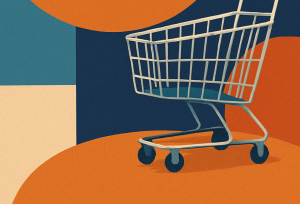
Share
By Alex Cramer
It took 63 million years for cavemen to evolve into modern man but in e-commerce, sometimes it only takes a few months for the entire market to change. Social commerce is the next big evolutionary step for online shopping and it is set to both accelerate and revolutionize how your brand makes sales.
According to Accenture, in 2021, the global retail social shopping market was worth $492 billion, and they are projecting it to grow to over $1.2 trillion in sales by 2025.
Part of this is driven by social networks desperate attempts to diversify their revenue streams, as changes to privacy and tracking rules make it harder for them to make money through advertising, as evidenced by Facebook posting its first-ever year-to-year revenue dip.
But another, and probably more important part, is that the growth of social commerce is a recognition the primacy of these networks in the lives of most internet users.
Globally, 3.5 billion people use social media, spending an average of two hours a day scrolling through different platforms. This means that if you’re a brand trying to create the shortest possible path between your product and your customer, then selling through social networks is the most logical move.
Robin Murdoch is Accenture’s global Software & Platforms industry lead says that “The pandemic showed how much people use social platforms as the entry point for everything they do online — news, entertainment and communication. The steady rise in time spent on social media reflects how essential these platforms are in our daily life. They’re reshaping how people buy and sell, which provides platforms and brands with new opportunities for user experiences and revenue streams.”
However, just understanding that change is coming isn’t enough. It’s important to know how you can position your brand to take advantage of it.
These are the most important trends in social commerce that your brand needs to be aware of.
Growth of User Generated Content
Effectively selling across social networks doesn’t mean that you need to develop an expensive, elaborate and slickly produced marketing campaign. Rather, social shoppers prefer authenticity to hype which means that they’re more likely to buy something if they see their friend using it as opposed to a celebrity endorser who they know is being paid to use the product.
By utilizing pictures, videos and other forms of media showing real people actually using and enjoying what you sell, you’ll be able to turn your own customers into your best salespeople.
To motivate people to submit content, you can sponsor contests or offer giveaways for your shoppers who submit the best user-created content or who can generate the most likes and shares by posting their own content on your channel.
Optimize for Voice Ordering
While making actual phone calls is one of the lowest use cases for most people with mobile phones, that doesn’t mean they aren’t using their voice. From dictating texts to using virtual assistants consumers are growing increasingly comfortable surfing the web with their voice as they are by typing and that goes for social shopping as well.
A study from Statista shows that US consumers made over $4.6 billion worth of voice-assisted e-commerce purchases in 2021 and that number is projected to grow to $19.4 billion by 2023.
Millennials and Gen-Z’ers are disproportionally more likely to use voice-assisted technology to make a purchase, which is the same demographic that is spending the most through social commerce.
As virtual assistants and voice-driven apps become increasingly integrated into most people’s lives, it’s important to make sure that your brand is optimized for this type of shopping experience.
Lead With Low Ticket Items
While social shopping is poised for massive growth that doesn’t mean that every vertical is going to share in the success. Social shopping tends to lead consumers to make fast purchase decisions, which means that it isn’t as well suited for the kind of high-ticket items that most buyers tend to take more time making up their mind about.
In other words, most people aren’t going to buy a $2,000 4K TV panel on a whim.
That’s why you should lead your channel with lower-priced, catchy and fun items that shoppers will be much more likely to impulse buy. Then, as they explore your brand further, you can lead them to your higher-priced products that they’ll want to spend more time considering before they buy.
Oliver Wright, global Consumer Goods and Services lead at Accenture observes that, “Getting social commerce right will require creators, resellers and brands to bring their products and services where the consumer is, and will be, rather than the other way around. It means working together within a dynamic ecosystem of platforms, marketplaces, social media and influencers to share data, insights and capabilities to deliver the right incentives and best consumer experience across an integrated digital marketplace.”
Social commerce is poised to become one of the most important shopping channels for e-commerce, and should particularly thrive with younger buyers who have already integrated their lives into their social profiles. Brands that want to thrive in the future need to understand how to make themselves a part of these buyers’ social experience.



